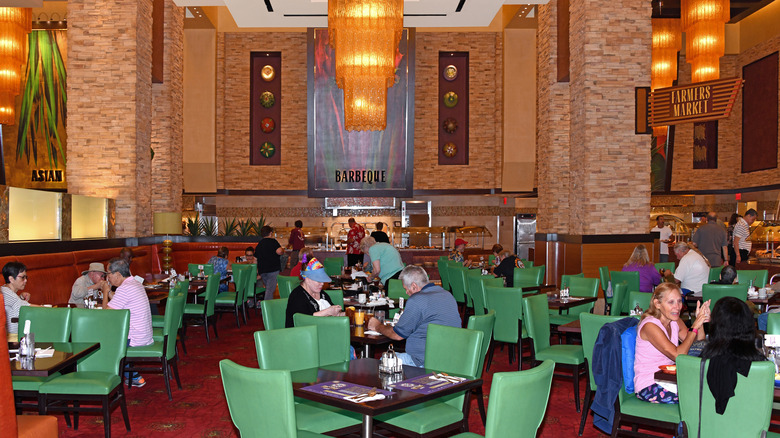How Las Vegas, Nevada, Became Known For Its Larger-Than-Life Buffets
Las Vegas, Nevada, is known for many things: gambling, drive-thru weddings, massive themed hotels, and, of course, the secrets it keeps (what happens there, stays there, after all). It's also a haven for foodies, with world-renowned and celebrity chefs like Bobby Flay opening must-visit restaurants both on and off the Strip. And then there's the buffets, Vegas-sized and often destinations in their own right.
While the heyday of the Vegas buffet may have passed — there are far fewer buffets in the city than there were several years ago – they remain an iconic part of the Sin City experience. But how did they become a mainstay? The roots of Vegas buffet culture trace back to the mid-20th century, when a plan to keep hungry gamblers at the tables led the El Rancho casino to start what they called a "chuck wagon," offering snacks and cold cuts. It became the Buckaroo Buffet, the first Vegas buffet, and the concept was quickly adopted by other casinos.
In true Las Vegas fashion, the buffets grew larger and more elaborate. By the 1970s, they were everywhere, prompting casinos to explore various methods to attract diners — from high-priced, opulent spreads to mind-boggling "super buffets" with hundreds of food items. This evolution gave rise to the modern buffet, which emphasizes spectacle with made-to-order options and chefs on display preparing the food. Today's Las Vegas buffets, whether offering luxury or comfort food, might look a little different, but carry on the tradition that has evolved over the past 75 years.
Is Vegas buffet culture over?
In 2020, the COVID-19 pandemic shut everything down — including Las Vegas. It would prove to be the beginning of the end of the ubiquity of the Vegas buffet. Only about a baker's dozen of the approximately 70 buffets that had operated in the city prior ultimately reopened. Off-Strip buffets still operate at a loss as a means to keep gamblers fed and spending money. But many on-Strip casinos refocused their energy on other dining options — such as the food hall, which has experienced heightened popularity in the past several years. Now, in addition to those remaining off the Strip, most buffets along Vegas Boulevard are either more limited in their opening hours and offerings, or are much more expensive and extravagant options, such as the Bacchanal at Caesars Palace. However, it's worth noting that the largest buffet in America isn't in Las Vegas.
Given the high cost of operating buffets, the reduction in their popularity leading up to the pandemic, and the overarching changes happening in Las Vegas, it seems that they may be a relic of the past. Despite many customers expressing nostalgia for buffets, stakeholders show little interest in reopening them, opting instead to focus on other aspects that enhance customer engagement and generate revenue for casinos. While the number of buffets may have dwindled, those that remain are still serving up satisfying experiences for hungry diners and buffet aficionados. And, who knows? Maybe someday they'll make a comeback.

